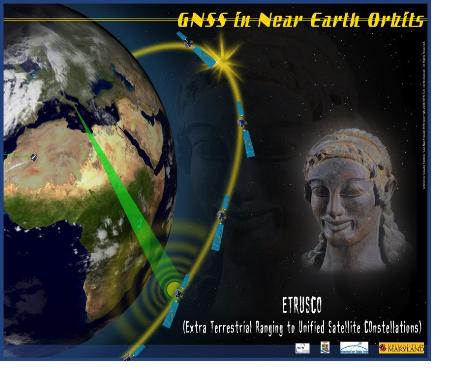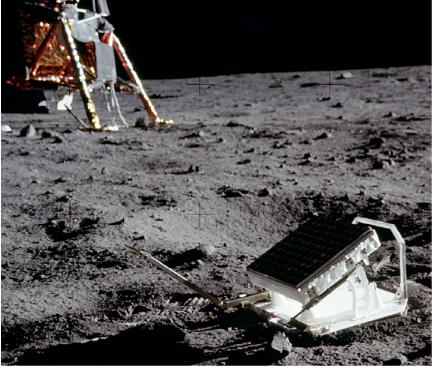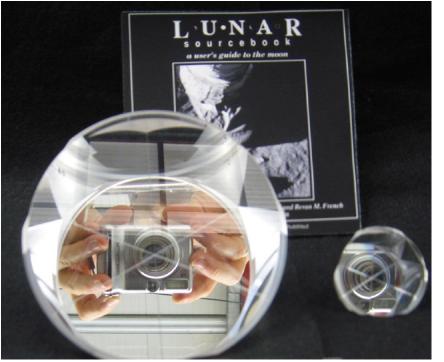This space research activity started in 2006, with the ETRUSCO experiment (Extra Terrestrial Ranging to Unified Satellite COnstellations), a truly interdisciplinary, international and inter-agency experiment of research and development (R&D). Led and coordinated by the Frascati National Laboratories (LNF) of the INFN, etrusco has involved American research centers (like the University of Maryland at College Park, UMD, and the Harvard-Smithsonian Center for Astrophysics), Italian industries and other Italian institutions: the Air Force, the ASI Center of Space Geodesy (CGS) in Matera and the University of Bologna. The most successful outcome of ETRUSCO has been the creation of a missing industry standard: an innovative experimental apparatus and test procedure for the space characterization of special ģmirrorsī, the cube corner laser retroreflectors. These are used for satellite tracking from laser Earth stations through a time of flight measurement. This laser ģrangingī technique gives an absolute and direct measurement of the position of artificial satellite and of the Moon with respect to the Earth’s center of mass. The latter is also called the ģgeocenterī and is the origin of the International Terrestrial Reference Frame (ITRF). This satellite and lunar laser ranging (SLR and LLR) are the most accurate and, at the same time, the most cost-effective techniques for precise orbit determination with respect to the ITRF. ETRUSCO-2 is the industrial evolution of the scientific experiment ETRUSCO that will be co-funded by ASI, INFN and Italian SMEs over the period 2010-2012. The two main goals of ETRUSCO-2 are: (1) the optimization and space quality certification of all the corner cubes of GALILEO, the European constellation of Global Navigation Satellite System (GNSS); (2) the integration between the standard microwave navigation technique (used by GPS), and the laser ranging; the global positioning will be, this way, ģunifiedī, that is based both on microwaves and on laser; thanks to this integration, GALILEO will be one order of magnitude more accurate than GPS. GALILEO will be consistent with GPS but it will provide widened and enhanced services for civilian, commercial and scientific fields. The principal technological innovations of GALILEO, compared with GPS, are: the use of more accurate atomic clocks (MASER instead than Cesium), a more reliable microwave signal and the setting of corner cube retroreflectors on all the 30 satellites, instead than only on two of them like for GPS. Therefore, GALILEO is a ģunifiedī i.e. based both on microwaves and laser. In 2010 a new 3-year R&D experiment started: MoonLIGHT-ILN (Moon Laser Instrumentation for General relativity High-accuracy Tests). This research is synergetic with ETRUSCO-2, since it aims to characterize the performance of 2nd generation lunar retroreflectors, to be installed over the Moon surface by next robotic missions, like those foreseen by the International Lunar Network (ILN, http://iln.arc.nasa.gov/). These new reflectors, optimized and qualified at INFN-LNF by LNF and UMD, will perform significantly better than the old reflectors deployed both by the American Apollo human missions and by the Soviet Lunokhod rovers. MoonLIGHT is an international collaboration among LNF, UMD, ASI-CGS, the University of California at San Diego (UCSD) and the Harvard-Smithsonian Center for Astrophysics (CfA). The latter provides an open source sophisticated software package to estimate the orbits of solar system natural bodies and of many artificial satellites. UCSD lead the best performing LLR ground station, the Apache Point Lunar Laser Ranging Operation (APOLLO) in the US. The work on the 2nd generation LLR payload is or has been supported in Italy by INFN through the MoonLIGHT experiment (approved for 2010-2012), by ASI though the Phase A Study for the MAGIA lunar Orbiter (call for Small Missions DC-PRZ-2007-002, 07/08/2007, Contract I/017/08/0). In the US it has been supported by NASA through two programs: (1) Lunar Sortie Scientific Opportunities (LSSO, Contract NNX07AV62G), (2) the LUNAR consortium (http://lunar.colorado.edu), headquartered at the University of Colorado, which is funded by the NASA Lunar Science Institute (via Cooperative Agreement NNA09DB30A) to investigate concepts for astrophysical observatories on the Moon. The applications of ETRUSCO and MoonLIGHT are global satellite navigation, space geodesy/selenodesy, gravitational physics and space exploration. |
||
 |
||
Figure 1: ETRUSCO poster, illustrating the concept of "unified" constellation, whose satellites are tracked both by microwaves and laser pulses. |
||
 |
||
Figure 2: Cube corner retroreflectors deployed on the Moon by Apollo missions and the large 2nd generation reflector developed by UMD and LNF. |
||
 |
||
Figure 3: The 2nd generation retroreflector developed by LNF and University of Maryland (left) next to a 1st generation Apollo reflector (right). |
||
Principal Investigator of ETRUSCO-2 (ASI-INFN) and MoonLIGHT-ILN (INFN): Dr. Simone Dell'Agnello, PhD, INFN-LNF I-00044, Italy |
||
MOONLIGHT-ILN
Responsabile Locale Simone dell'Agnello
Bellettini Giovanni, Berardi Simone, Bianco Giuseppe, Boni Alessandro, Cantone Claudio, Dell'Agnello Simone, Delle Monache Giovanni Ottavio, Garattini Marco, Graziosi Chiara, Intaglietta Nicola, Lops Caterina, Maiello Mauro, March Riccardo, Martini Manuele, Patrizi Giordano, Porcelli Luca, Tauraso Roberto, Tibuzzi Mattia, Vittori Roberto